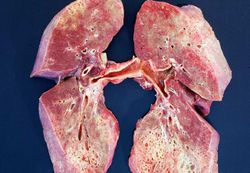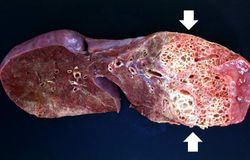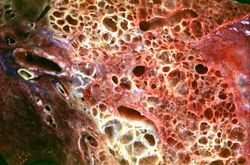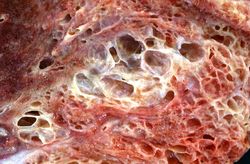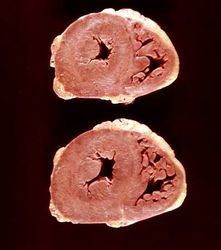Difference between revisions of "IPLab:Lab 6:Scleroderma"
Seung Park (talk | contribs) |
(→Autopsy Findings) |
||
| (2 intermediate revisions by the same user not shown) | |||
| Line 2: | Line 2: | ||
This 29-year-old black female had a history of scleroderma involving the lung, kidney, heart, and skin. Her main clinical problems centered on her restrictive lung disease. She was able to live at home with supplemental oxygen but recently she had developed edema, chest pain, weakness, light-headedness, and a loss of appetite. The patient was admitted to the hospital with a working diagnosis of congestive heart failure brought on by her lung disease. Echocardiographic evaluation revealed a pericardial effusion that was tapped. Soon after this procedure her respiratory status degenerated and she required intubation. Despite aggressive supportive treatment for her cardiac and pulmonary problems, she could not be weaned from the ventilator. Two weeks after admission she became febrile and Gram positive cocci were isolated from sputum culture. She was placed on antibiotics but her condition deteriorated and she developed bradycardia followed by electromechanical dissociation (EMD). | This 29-year-old black female had a history of scleroderma involving the lung, kidney, heart, and skin. Her main clinical problems centered on her restrictive lung disease. She was able to live at home with supplemental oxygen but recently she had developed edema, chest pain, weakness, light-headedness, and a loss of appetite. The patient was admitted to the hospital with a working diagnosis of congestive heart failure brought on by her lung disease. Echocardiographic evaluation revealed a pericardial effusion that was tapped. Soon after this procedure her respiratory status degenerated and she required intubation. Despite aggressive supportive treatment for her cardiac and pulmonary problems, she could not be weaned from the ventilator. Two weeks after admission she became febrile and Gram positive cocci were isolated from sputum culture. She was placed on antibiotics but her condition deteriorated and she developed bradycardia followed by electromechanical dissociation (EMD). | ||
| − | + | Upon opening the thorax at autopsy there was 600 cc of cloudy serous fluid in each hemithorax and 100 cc of similar fluid in the pericardial sac. The heart weighed 530 grams and there was thickening of both the left and right ventricular walls. The liver weighed 1880 grams and was congested. The spleen weighed 200 grams and was also congested. The combined lung weight was 1875 grams; the lungs were markedly fibrotic with severe emphysema. In addition, dermal thickening was evident throughout the body and the wall of the esophagus was thickened and firm. | |
| − | Upon opening the thorax there was 600 cc of cloudy serous fluid in each hemithorax and 100 cc of similar fluid in the pericardial sac. The heart weighed 530 grams and there was thickening of both the left and right ventricular walls. The liver weighed 1880 grams and was congested. The spleen weighed 200 grams and was also congested. The combined lung weight was 1875 grams; the lungs were markedly fibrotic with severe emphysema. In addition, dermal thickening was evident throughout the body and the wall of the esophagus was thickened and firm. | ||
== Images == | == Images == | ||
| Line 15: | Line 14: | ||
== Virtual Microscopy == | == Virtual Microscopy == | ||
| − | === Lung === | + | === Lung: Scleroderma === |
<peir-vm>IPLab6Scleroderma</peir-vm> | <peir-vm>IPLab6Scleroderma</peir-vm> | ||
| − | === Skin === | + | === Normal Lung === |
| + | <peir-vm>UAB-Histology-00107</peir-vm> | ||
| + | |||
| + | === Skin: Scleroderma === | ||
<peir-vm>IPLab6Scleroderma_Skin</peir-vm> | <peir-vm>IPLab6Scleroderma_Skin</peir-vm> | ||
| + | |||
| + | === Normal Skin === | ||
| + | <peir-vm>UAB-Histology-00004</peir-vm> | ||
== Study Questions == | == Study Questions == | ||
Latest revision as of 23:38, 8 July 2020
Contents
Clinical Summary[edit]
This 29-year-old black female had a history of scleroderma involving the lung, kidney, heart, and skin. Her main clinical problems centered on her restrictive lung disease. She was able to live at home with supplemental oxygen but recently she had developed edema, chest pain, weakness, light-headedness, and a loss of appetite. The patient was admitted to the hospital with a working diagnosis of congestive heart failure brought on by her lung disease. Echocardiographic evaluation revealed a pericardial effusion that was tapped. Soon after this procedure her respiratory status degenerated and she required intubation. Despite aggressive supportive treatment for her cardiac and pulmonary problems, she could not be weaned from the ventilator. Two weeks after admission she became febrile and Gram positive cocci were isolated from sputum culture. She was placed on antibiotics but her condition deteriorated and she developed bradycardia followed by electromechanical dissociation (EMD).
Upon opening the thorax at autopsy there was 600 cc of cloudy serous fluid in each hemithorax and 100 cc of similar fluid in the pericardial sac. The heart weighed 530 grams and there was thickening of both the left and right ventricular walls. The liver weighed 1880 grams and was congested. The spleen weighed 200 grams and was also congested. The combined lung weight was 1875 grams; the lungs were markedly fibrotic with severe emphysema. In addition, dermal thickening was evident throughout the body and the wall of the esophagus was thickened and firm.
Images[edit]
Virtual Microscopy[edit]
Lung: Scleroderma[edit]
Normal Lung[edit]
Skin: Scleroderma[edit]
Normal Skin[edit]
Study Questions[edit]
- What organs are usually affected in patients with scleroderma (progressive systemic sclerosis, PSS)?
Additional Resources[edit]
Reference[edit]
- eMedicine Medical Library: Scleroderma
- eMedicine Medical Library: CREST Syndrome
- Merck Manual: Systemic Sclerosis
Images[edit]
Related IPLab Cases[edit]
A pericardial effusion is a collection of fluid within the pericardial space.
Bradycardia is defined as a heart rate below 60 beats per minute. A normal heart rate for a neonate is 100 to 160 beats per minute.
EMD is a condition in which the heart's electrical rhythm continues despite the mechanical failure of the myocardium.
A normal heart weighs 300 grams (range: 270 to 360 grams).
A normal liver weighs 1650 grams (range: 1500 to 1800 grams).
The normal spleen weighs 155 grams.
A normal pair of lungs weighs 825 grams (range: 685 to 1050 grams).
Pulmonary emphysema is a condition in which the air spaces distal to the terminal bronchioles are permanently increased in size due to either destruction of the wall or alveolar dilatation.
